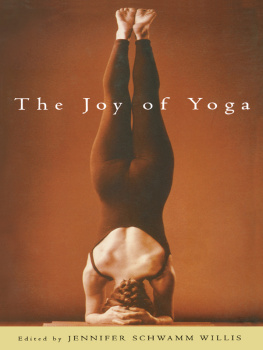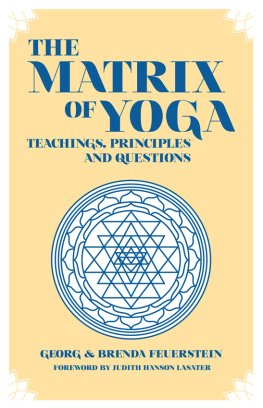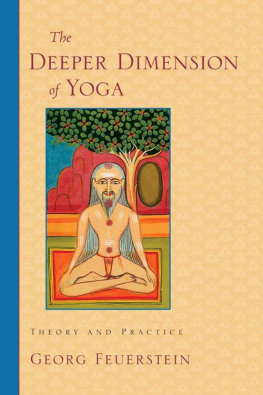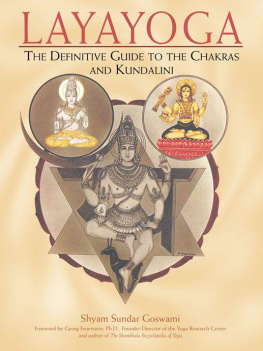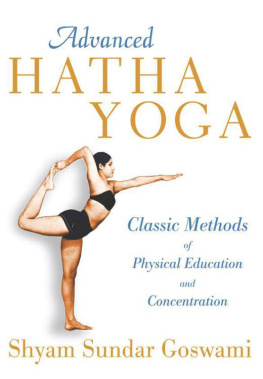
Foundations of Yoga
In Foundations of Yoga, Basile P. Catomris presents a comprehensive view of the ancient practice of Yoga through the eyes of a present-day yogi. Those interested in the roots of yogic philosophy and practice will find his clear explanations informative and enlightening.
BIFF MITHOEFER, INTERNATIONAL YOGA TEACHER AND
AUTHOR OF THE YIN YOGA KIT AND COAUTHOR
OF THE THERAPEUTIC YOGA KIT
It is with the greatest pleasure that I recommend Basile P. Catomriss book Foundations of Yoga. Sri Shyam Sundar Goswami and his understanding and practical application of Hatha Yoga has been instrumental in spreading this form of Yoga in the West. The increased interest in the practice of Hatha Yoga in Europe and the United States makes this book especially important.
OLLE QVARNSTRM, PROFESSOR OF
INDIC RELIGIONS, LUND UNIVERSITY, SWEDEN
Foreword

Gunnar Adler-Karlsson
In his introduction to this book, Basile P. Catomris mentions that Professor S. S. Goswami attracted thousands of pupils to his Yoga school in Stockholm. Fortunately, I was one of the lucky ones. At the beginning of the 1960s, I overexerted myself on an academic book concerning the extremely sensitive and secret economic side of the Cold War, became a bit nervous, and went to a doctor. The only fault he found was that I had worked too hard with my mind, neglecting my body. He gave me the address of the Goswami school.
Since then I have had close encounters with a number of statesmen and Nobel Prize winners. But I have never in my life met an individual with a stronger charisma combined with such a wonderful mixture of empathy, warm humor, and profound seriousness as Sri Shyam Sundar Goswami. His Haha Yoga exercises, together with some deep meditation, quickly picked up both my physical and mental state. For over forty years since then, few weeks have passed without my doing a serious Yoga exercise.
I have no doubt that it was Professor Goswamis Yoga teaching that gave me the strength to overcome those difficulties in life that all truth-seekingthat is, provocativeindividuals are bound to meet. In this superstressed modern world I dont hesitate to advise anybody and everybody to devote a few hours a week to Haha Yoga. All the other hours will benefit from it, and you will enjoy a stronger body and a quicker, as well as more relaxed, mind.
Lest the reader think I am a fundamentalist Yoga fanatic, let me just mention that an English translation of the title of my latest book in Swedish could be Memories of an Inflated Bacteria. This scientifically fully correct phrase is a reminder of Goswamis Indian wisdom, tat twam asi: you are ityou are the great-great-great grandchild of the first bacteria at the beginning of life on this wonderful planet.
My own memory of and gratitude to Sri Shyam Sundar Goswami will continue until the other bacteria seriously start to consume me.
Preface

Yoga is the inseparable heart of the Hindu school of thought. It is said, There is no Yoga without Hinduism and no Hinduism without Yoga. On the other hand, the renowned father of analytical psychology, Carl G. Jung, described Yoga as one of the greatest things the human mind has ever created.
Yoga is a vast subject. Moreover, a serious study of it cannot limit itself to a fragmentary account of its techniques and methods, as is too often the case today. The study of Yoga effectively requires a broad, and above all accurate, understanding of the different aspects of Yoga: spiritual, metaphysical, and philosophical, as well as its conception of human psychology. The original literature on Yoga consisted of manuscripts primarily written in Sanskrit, which were the fruit of interpretations by its practitioners, who were intuitive and empirical and, at the same time, faithful and enlightened.
These days, there is no rule or formal requirement for the teaching of Yoga. A liberal attitude of this kind, together with the popularization of this precious source of human knowledge, has resulted in the circulation of numerous misunderstandings about and amalgams of the nature, traditional values, and objectives of Yoga. Numerous self-proclaimed masters, either because of naivet or lack of respect for a sacred tradition, have failed to obtain serious theoretical and practical training; as a result they pass along ineptitudes and untruths. Sometimes they claim an altruistic motivation; often they reveal overtly mercantile ambitions. It should be noted, moreover, that representatives of very honorable professions, in a learned manner supported by rational analysis, laud the benefits of such or such an sana or posture, thus encouraging less aware individuals to take an la carte approach to something that in fact constitutes a wholea holistic doctrine that requires an integrated approach.
In the wake of the ongoing Yoga renaissance, a plethora of Yoga schools with various sana management programs has emerged all over the world. On several worldwide traveling occasions, I had the opportunity to assess how sanas are interpreted in various Yoga schools and ashrams of India, Europe, the United States, and the Middle East. Quite impartially, and with due respect to the managers of Yoga schools and institutions, whether they are promoting Hindu culture, business-oriented, or just dilettante, I must say that I found the most intelligent, methodically designed sana training at the Goswami Yoga institute of Stockholm, Sweden, reportedly Europes oldest Yoga school. There pupils can discover a complete use of traditional sanas that have been rationally adapted to meet the needs of urban practitioners. Four different courses are available: an all-round program involving virtually the whole musculature, a program of essentially static sanas, one course called Mah Mudr with an anaerobic training of the lungs, as well as an intensive program with emphasis on the heart and the lungs. This program embraces the complete range of human physical activity: flexibility, strength, speed, and endurance.
On another note, more formal but nevertheless representative of an offense consistent with the level of ignorance, indeed disdain, that is accorded to traditions, is the frequent abuse of the term guru. Sacred in India, the holy teachers who are addressed with this term are done a disservice by the indiscriminate use of the word in the West, where it is used to refer to the worst alongside the best, notably the leaders of sects that have little to recommend them or in some cases are even contemptible.
It is to dispel numerous such mistaken ideas that I am presenting to the English reader a synthesis of Yoga according to the oral and written teachings of Sri Shyam Sundar Goswami, an incontrovertible Yoga master, who is nevertheless unknown in many parts of the West. Foundations of Yoga is intended to express an Indo-Europeans indebtedness and to bear witness to my profound loyalty, which is inseparable from my immense debt of gratitude to one of Indias great spiritual sons.
Here it is useful to specify the nature and role of the yogi as one who has, in the Hindu tradition, attained the state of samdhi, an epiphanic experience (in the etymological sense of the term) of a state of immediate insight that reveals the essence of a given object to the subject. A yogi (or yogini) is not necessarily a guru or a learned person, yet in India yogi(ni)s enjoy a high social status. It is said that wealthy and mighty maharajas of lore would search for the presence of a yogi(ni) in their genealogy to reinforce their noble lineage. There are numerous yogis in India who do not wish to appear in public or to reveal the fruit of their spiritual experiences, even to those close to them.
Next page

